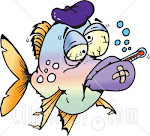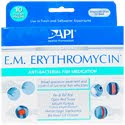Aquarium Copper Facts and Use; Cupramine, Copper-Safe, Testing

Overview:
Copper has long time been used for treatment of aquarium algae, fish parasites, and snail eradication. This includes external treatment of freshwater and marine Ich, Oodinium, and fungus. It is has been said on popular aquatic sites, that people are attracted to using Copper as a treatment in the display tank, because it does not discolor the tank, but with using Copper, caution and some understanding does needs to be involved. Improper use can cause harm to the tank. Water chemistry and other environmental factors will determine dosing details of the Copper treatment.
The Copper used for treatments can stay in a tank for close to a month. If there are any live rocks or ornaments in the tank, the Copper will be absorbed into the material and slowly lech it's way back out. There are only certain ways to remove the Copper from the water, which is one reason to use caution. This is something I will go into later in this post.
A certain level of Copper concentration is required for an effective treatment, and is different depending on tank needs. These therapeutic levels can become toxic to other fish species and invertebrates in the tank. This is another reason why caution needs to be used with this treatment. Chronic use of Copper will affect fish health. Higher levels can damage fish gills and other body tissues. It has also been shown that there is a decrease in fish immunity, with chronic use (Yanong2, 2013).
The use of Copper in low pH can become even more toxic, so much more caution needs to be used. Not only is copper more toxic in acidic water, but the acidic water itself can be a problem. In fact, when the pH is below 6.4, the helpful, nitrifying bacteria in your aquarium begin to stop functioning.
Here are some caution Copper levels to be aware of:
- Dangerous level of copper for shrimps is 0.03 mg per litre.
- Dangerous level of copper for algae and bacteria is 0.08 mg per litre.
- Dangerous level of copper for some fish, snails and plants is 0.10 mg per litre.
Copper will need to be maintained at least at 0.12-0.18 mg/L and for a therapeutic level and for no less than 14 days(Blasiola,2000,p.146).
Here are some therapeutic levels that will help:
- .15-.20 ppm for Oodinium/Brooklynella (most freshwater applications)
- .20-.25 ppm for Crytocaryon
A note for marine tanks, the amount of copper you will need to add for treatment, will be high initially, but then will need to be brought down over subsequent days. Copper will be absorbed into corals and substrate, to the point no more Copper is absorbed. This needs to be taken into account when attempting to maintain a therapeutic level.
This is mainly important for treatment of display tanks, but is not something to worry about for bare hospital tanks.
Note: Copper basically kills parasites by poisoning them more than the fish, so never over dose!
Always have a copper test-kit on hand!

Do not use with snails and invertebrates. Do not use in reef aquariums and note; when used as an algaecide, the copper is absorbed by the algae then released when it dies.
Basic Copper:
Copper is a heavy mental that can be found naturally in many forms. The form of Copper that is typically used in aquarium set-ups Copper Sulfate, or properly known as Copper Sulfate Pentahydrate. The reason this form of Copper is used, is when it is placed in water it dissolves and attaches to the most water molecules. During this process, Copper Sulfate splits into Copper (Cu2+) separately and Sulfate, along with water. It is strictly the Copper (Cu2+) that is measured and used to combat a number of issues within the tank. Like stated before, maintaining proper levels of Copper Sulfate can be difficult because of other components in the tank, such as Carbonates, which are part of Dolomite, which when dissolved can become complex and remove the Copper. Also, other living organisms can bind to the element, which effects levels.
There is also Chelated Copper, which is a compound added to Copper Sulfate. These agents help keep Copper in a solution by forming a ring structured Copper. These complexes become stable in a different form and more of a complex form of treatment. For the most part, most aquarium keepers use Copper Sulfate rather than Chelated Copper, because of the strength and the difference in effort to remove the treatment from the tank. The use of Chelated Copper is advised only in hospital tanks.
Because Copper can be difficult to dose, after figuring out the amount needed for your tank and needs, start the dosing amount at half the amount! This is best done by mixing the Copper Sulfate with some distilled water. In marine tanks, add half of the mixed solution to the sump and the other half to the tank, so to miss all of the "hot spots" in the tank. Make sure not to add high amounts of Copper to the sump as it can damage the biofilter by killing beneficial bacteria. After the Copper has been in the water cycle long enough and has equally distributed, then measure the Copper levels. Add more Copper, allow it to mix and re-measure until the concentration levels are met.
Often, due to binding (adsorption) of Copper to components of the system, more Copper than the amount calculated initially will be needed to reach the appropriate concentration. Copper measurements should be taken twice a day, with more copper added if necessary. As discussed previously, treatment may last 3–4 weeks or more, depending upon the target organism and specific situation.
ADVERTISEMENT
Treatment:
Treat based on what solution you are using, but try to bring your Copper level to .15 -.20 ppm for Oodinium/Brooklynella (and most freshwater applications) and .20- .25 ppm for Crytocaryon. Please revisit the therapeutic levels I stated above. Generally, it is easier to maintain these levels, while not having to do repeat testing and follow-up dosing, while using Chelated Copper, but please remember the use of a hospital tank.
When treating a tank, make sure all materials and filtration component (ie. carbon) are removed. If necessary, high organic bioloads or detritus should be removed. Baseline water parameters should be check prior to treatment. This includes, ammonia, nitrite, pH, temperature, alkalinity, and salinity. Gradually dose to the therapeutic level over a 2-3 day span. This allows time for the fish to increase internal and physiological mechanisms to protect their bodies against the toxicity.
Contraindications:
- Wait 2-4 hours to add after use of any water Redox reducing water conditioners. This will include SeaChem Prime, Kordon Novaqua, Kordon Amquel, Jungle Start Right, API Stress Coat, etc.
- Use in aquarium systems that have an established healthy bio filter.
- Do not mix with Sulfa based treatments/medications.
Removal:
High quality active Carbon will do the trick for removing Copper. You can place a separate filtration unit containing fresh, activated charcoal at the rate of 170 grams per 57 liters of water (about 0.375 lbs per 15 gallons) on a system to remove Copper. Once all the water has cycled through the carbon, test for free copper concentration. If Chelated Copper has been used, water changes will be necessary. Dolomite may also be used, if it is removed afterward. If tests continue to show a high free Copper concentration, a complete water change may still be required to remove copper from the water. Copper levels should be monitored throughout this process and for several weeks afterward, in case Copper that was previously bound to substrate or complexed in solution, is released as free copper.
WHERE TO PURCHASE:
VIDEO
AAP Professional Aquarium & Pond Medications
THE BEST AQUARIUM TREATMENTS ANYWHERE IN THE WORLD! Fresh Product found EXCLUSIVELY at AAP
- Aquarium Medications Part 1, How to Use
- Aquarium Medications Part 3, Chemical; Copper
- Use of Copper in Marine Aquaculture and Aquarium Systems
- The Aquarium Wiki; Copper
- The Saltwater Aquarium Handbook, By George C. Blasiola; Copper
Suggested other aquarium information resources & products:

AAP Spectrogram
THERE IS NO MORE EFFECTIVE treatment for Fish Columnaris!!

Fish Diseases | How to Treat Sick Fish

AAP Hydro Sponge Filters
THE PREMIUM Aquarium Sponge Filter with as much as 5 TIMES the bio and mechanical capacity of commonly sold Chinese knock offs!!
Definitely worth the extra $1-3
Labels: algae, aquarium copper, Chelated Copper, Copper Sulfate, Cryptocaryon, external parasites, freshwater and marine ich, fungus, Oodinium, Pentahydrate, shimmy, treatments







